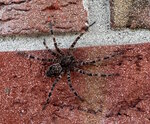, 0°
Wind: mph
The other day, as I made my way to the entrance of my favorite grocery store, a movement on the pavement caught my attention. Scurrying toward the building’s brick facade was a super spider of …
Stay informed about your community and support local independent journalism.
Subscribe to The River Reporter today. click here
This item is available in full to subscribers.
Please log in to continue |


The other day, as I made my way to the entrance of my favorite grocery store, a movement on the pavement caught my attention. Scurrying toward the building’s brick facade was a super spider of impressive proportions. In the latest example of “another nutty naturalist on the loose,” I aimed my smartphone camera at the creepy crawler and snapped away as curious customers slowed down, then hurried off, a bit horrified at what resembled a small tarantula.
The eye-catching critter turned out to be a fishing spider, one of our largest local species. Dolomedes is a genus of spiders of the family Pisauridae. There are over a hundred species of Dolomedes throughout the world, with nine species in North America. Commonly referred to as raft spiders, dock spiders or wharf spiders, most are semi-aquatic and tend to frequent waterways.
This specimen appeared to be Dolomedes tenebrosus (dark fishing spider), which is more often found away from water, as was the case in this situation.
Fishing spiders feed primarily on small insects and are opportunistic ambush hunters that feed mostly at night to avoid their primary predators, which are birds.
A chief characteristic of female fishing spiders is the construction of an egg sac which is carried in the chelicerae (jaw-like or fang-bearing appendages), even when hunting. It is discarded when the spiderlings emerge. A YouTube video of this species mating can be seen at www.youtube.com/watch?v=PUtWvbi2kTI .
Spiders play important roles in any ecosystem because they are numerous and are voracious insect predators. Encountering spiders—even large hairy ones—is not reason for panic. If one makes its way into your home, it can easily be relocated outdoors by gently placing a cup over the spider and carefully sliding something like a postcard under the cup’s opening.
I used to have an irrational fear of spiders that I gradually overcame by observing them and learning about their behaviors. For several months, I studied a house spider as she built webs, caught and consumed countless insects and deposited tiny balloon-like egg sacs out of which tiny spiderlings emerged. It was a transformative experience that heightened my appreciation for all spiders and freed me from fearing them.
To read a fascinating account of a similar experience, see the poet Mary Oliver’s essay, “Swoon,” in her book “Winter Hours.”
Comments
No comments on this item Please log in to comment by clicking here